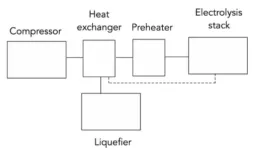To continue reducing the costs of solar energy and other clean energy technologies, scientists and engineers will likely need to focus, at least in part, on improving technology features that are not based on hardware, according to MIT researchers. They describe this finding and the mechanisms behind it in Nature Energy.
While the cost of installing a solar energy system has dropped by more than 99 percent since 1980, this new analysis shows that “soft technology” features, such as the codified permitting practices, supply chain management techniques, and system design processes that go into deploying a solar energy plant, contributed only 10 to 15 percent of total cost declines. Improvements to hardware features were responsible for the lion’s share.
But because soft technology is increasingly dominating the total costs of installing solar energy systems, this trend threatens to slow future cost savings and hamper the global transition to clean energy, says the study’s senior author, Jessika Trancik, a professor in MIT’s Institute for Data, Systems, and Society (IDSS).
Trancik’s co-authors include lead author Magdalena M. Klemun, a former IDSS graduate student and postdoc who is now an assistant professor at the Hong Kong University of Science and Technology; Goksin Kavlak, a former IDSS graduate student and postdoc who is now an associate at the Brattle Group; and James McNerney, a former IDSS postdoc and now senior research fellow at the Harvard Kennedy School.
The team created a quantitative model to analyze the cost evolution of solar energy systems, which captures the contributions of both hardware technology features and soft technology features.
The framework shows that soft technology hasn’t improved much over time — and that soft technology features contributed even less to overall cost declines than previously estimated.
Their findings indicate that to reverse this trend and accelerate cost declines, engineers could look at making solar energy systems less reliant on soft technology to begin with, or they could tackle the problem directly by improving inefficient deployment processes.
“Really understanding where the efficiencies and inefficiencies are, and how to address those inefficiencies, is critical in supporting the clean energy transition. We are making huge investments of public dollars into this, and soft technology is going to be absolutely essential to making those funds count,” says Trancik.
“However,” Klemun adds, “we haven’t been thinking about soft technology design as systematically as we have for hardware. That needs to change.”
The hard truth about soft costs
Researchers have observed that the so-called “soft costs” of building a solar power plant — the costs of designing and installing the plant — are becoming a much larger share of total costs. In fact, the share of soft costs now typically ranges from 35 to 64 percent.
“We wanted to take a closer look at where these soft costs were coming from and why they weren’t coming down over time as quickly as the hardware costs,” Trancik says.
In the past, scientists have modeled the change in solar energy costs by dividing total costs into additive components — hardware components and nonhardware components — and then tracking how these components changed over time.
“But if you really want to understand where those rates of change are coming from, you need to go one level deeper to look at the technology features. Then things split out differently,” Trancik says.
The researchers developed a quantitative approach that models the change in solar energy costs over time by assigning contributions to the individual technology features, including both hardware features and soft technology features.
For instance, their framework would capture how much of the decline in system installation costs — a soft cost — is due to standardized practices of certified installers — a soft technology feature. It would also capture how that same soft cost is affected by increased photovoltaic module efficiency — a hardware technology feature.
With this approach, the researchers saw that improvements in hardware had the greatest impacts on driving down soft costs in solar energy systems. For example, the efficiency of photovoltaic modules doubled between 1980 and 2017, reducing overall system costs by 17 percent. But about 40 percent of that overall decline could be attributed to reductions in soft costs tied to improved module efficiency.
The framework shows that, while hardware technology features tend to improve many cost components, soft technology features affect only a few.
“You can see this structural difference even before you collect data on how the technologies have changed over time. That’s why mapping out a technology’s network of cost dependencies is a useful first step to identify levers of change, for solar PV and for other technologies as well,” Klemun notes.
Static soft technology
The researchers used their model to study several countries, since soft costs can vary widely around the world. For instance, solar energy soft costs in Germany are about 50 percent less than those in the U.S.
The fact that hardware technology improvements are often shared globally led to dramatic declines in costs over the past few decades across locations, the analysis showed. Soft technology innovations typically aren’t shared across borders. Moreover, the team found that countries with better soft technology performance 20 years ago still have better performance today, while those with worse performance didn’t see much improvement.
This country-by-country difference could be driven by regulation and permitting processes, cultural factors, or by market dynamics such as how firms interact with each other, Trancik says.
“But not all soft technology variables are ones that you would want to change in a cost-reducing direction, like lower wages. So, there are other considerations, beyond just bringing the cost of the technology down, that we need to think about when interpreting these results,” she says.
Their analysis points to two strategies for reducing soft costs. For one, scientists could focus on developing hardware improvements that make soft costs more dependent on hardware technology variables and less on soft technology variables, such as by creating simpler, more standardized equipment that could reduce on-site installation time.
Or researchers could directly target soft technology features without changing hardware, perhaps by creating more efficient workflows for system installation or automated permitting platforms.
“In practice, engineers will often pursue both approaches, but separating the two in a formal model makes it easier to target innovation efforts by leveraging specific relationships between technology characteristics and costs,” Klemun says.
“Often, when we think about information processing, we are leaving out processes that still happen in a very low-tech way through people communicating with one another. But it is just as important to think about that as a technology as it is to design fancy software,” Trancik notes.
In the future, she and her collaborators want to apply their quantitative model to study the soft costs related to other technologies, such as electrical vehicle charging and nuclear fission. They are also interested in better understanding the limits of soft technology improvement, and how one could design better soft technology from the outset.
This research is funded by the U.S. Department of Energy Solar Energy Technologies Office.
###
Written by Adam Zewe, MIT News
END


